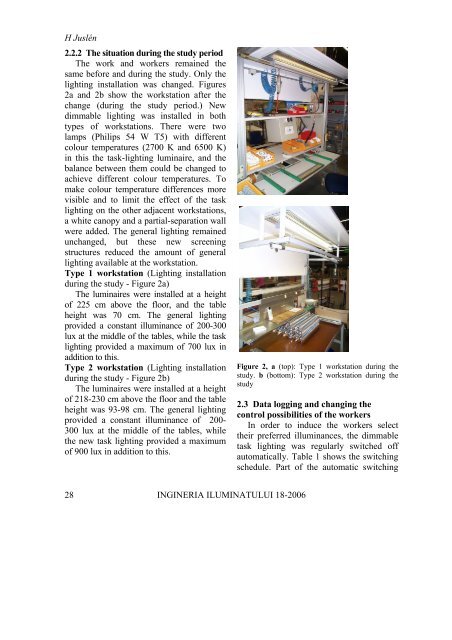This issue is sponsored by the Philips Romania, Lighting Division
This issue is sponsored by the Philips Romania, Lighting Division
This issue is sponsored by the Philips Romania, Lighting Division
Create successful ePaper yourself
Turn your PDF publications into a flip-book with our unique Google optimized e-Paper software.
H Juslén<br />
2.2.2 The situation during <strong>the</strong> study period<br />
The work and workers remained <strong>the</strong><br />
same before and during <strong>the</strong> study. Only <strong>the</strong><br />
lighting installation was changed. Figures<br />
2a and 2b show <strong>the</strong> workstation after <strong>the</strong><br />
change (during <strong>the</strong> study period.) New<br />
dimmable lighting was installed in both<br />
types of workstations. There were two<br />
lamps (<strong>Philips</strong> 54 W T5) with different<br />
colour temperatures (2700 K and 6500 K)<br />
in th<strong>is</strong> <strong>the</strong> task-lighting luminaire, and <strong>the</strong><br />
balance between <strong>the</strong>m could be changed to<br />
achieve different colour temperatures. To<br />
make colour temperature differences more<br />
v<strong>is</strong>ible and to limit <strong>the</strong> effect of <strong>the</strong> task<br />
lighting on <strong>the</strong> o<strong>the</strong>r adjacent workstations,<br />
a white canopy and a partial-separation wall<br />
were added. The general lighting remained<br />
unchanged, but <strong>the</strong>se new screening<br />
structures reduced <strong>the</strong> amount of general<br />
lighting available at <strong>the</strong> workstation.<br />
Type 1 workstation (<strong>Lighting</strong> installation<br />
during <strong>the</strong> study - Figure 2a)<br />
The luminaires were installed at a height<br />
of 225 cm above <strong>the</strong> floor, and <strong>the</strong> table<br />
height was 70 cm. The general lighting<br />
provided a constant illuminance of 200-300<br />
lux at <strong>the</strong> middle of <strong>the</strong> tables, while <strong>the</strong> task<br />
lighting provided a maximum of 700 lux in<br />
addition to th<strong>is</strong>.<br />
Type 2 workstation (<strong>Lighting</strong> installation<br />
during <strong>the</strong> study - Figure 2b)<br />
The luminaires were installed at a height<br />
of 218-230 cm above <strong>the</strong> floor and <strong>the</strong> table<br />
height was 93-98 cm. The general lighting<br />
provided a constant illuminance of 200-<br />
300 lux at <strong>the</strong> middle of <strong>the</strong> tables, while<br />
<strong>the</strong> new task lighting provided a maximum<br />
of 900 lux in addition to th<strong>is</strong>.<br />
28<br />
INGINERIA ILUMINATULUI 18-2006<br />
Figure 2, a (top): Type 1 workstation during <strong>the</strong><br />
study. b (bottom): Type 2 workstation during <strong>the</strong><br />
study<br />
2.3 Data logging and changing <strong>the</strong><br />
control possibilities of <strong>the</strong> workers<br />
In order to induce <strong>the</strong> workers select<br />
<strong>the</strong>ir preferred illuminances, <strong>the</strong> dimmable<br />
task lighting was regularly switched off<br />
automatically. Table 1 shows <strong>the</strong> switching<br />
schedule. Part of <strong>the</strong> automatic switching
















